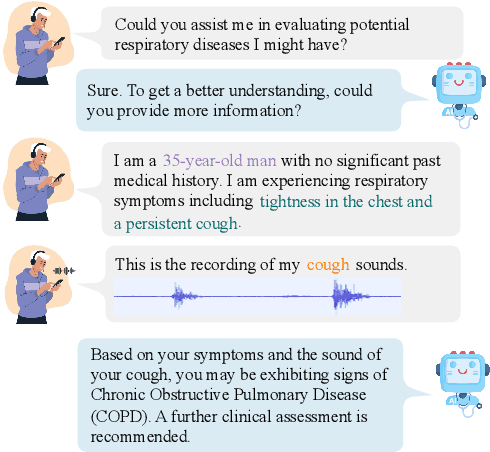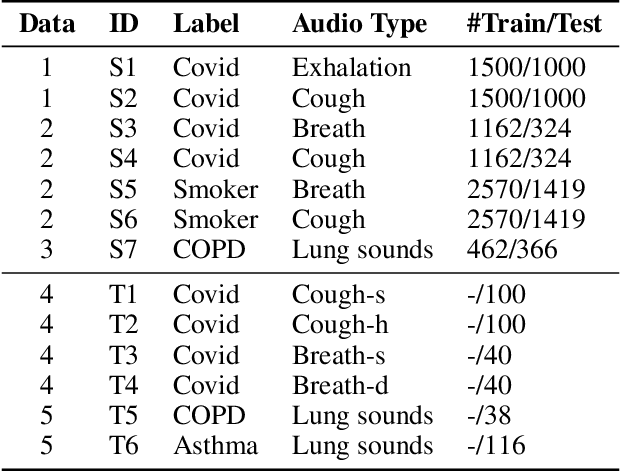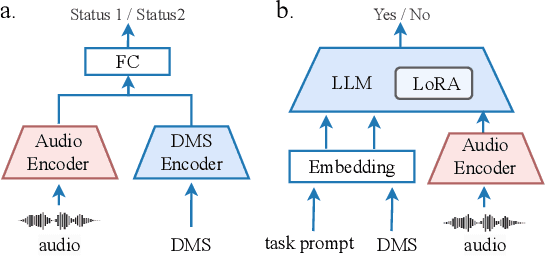Cecilia Mascolo
SensorLM: Learning the Language of Wearable Sensors
Jun 10, 2025Abstract:We present SensorLM, a family of sensor-language foundation models that enable wearable sensor data understanding with natural language. Despite its pervasive nature, aligning and interpreting sensor data with language remains challenging due to the lack of paired, richly annotated sensor-text descriptions in uncurated, real-world wearable data. We introduce a hierarchical caption generation pipeline designed to capture statistical, structural, and semantic information from sensor data. This approach enabled the curation of the largest sensor-language dataset to date, comprising over 59.7 million hours of data from more than 103,000 people. Furthermore, SensorLM extends prominent multimodal pretraining architectures (e.g., CLIP, CoCa) and recovers them as specific variants within a generic architecture. Extensive experiments on real-world tasks in human activity analysis and healthcare verify the superior performance of SensorLM over state-of-the-art in zero-shot recognition, few-shot learning, and cross-modal retrieval. SensorLM also demonstrates intriguing capabilities including scaling behaviors, label efficiency, sensor captioning, and zero-shot generalization to unseen tasks.
LeanTTA: A Backpropagation-Free and Stateless Approach to Quantized Test-Time Adaptation on Edge Devices
Mar 20, 2025Abstract:While there are many advantages to deploying machine learning models on edge devices, the resource constraints of mobile platforms, the dynamic nature of the environment, and differences between the distribution of training versus in-the-wild data make such deployments challenging. Current test-time adaptation methods are often memory-intensive and not designed to be quantization-compatible or deployed on low-resource devices. To address these challenges, we present LeanTTA, a novel backpropagation-free and stateless framework for quantized test-time adaptation tailored to edge devices. Our approach minimizes computational costs by dynamically updating normalization statistics without backpropagation, which frees LeanTTA from the common pitfall of relying on large batches and historical data, making our method robust to realistic deployment scenarios. Our approach is the first to enable further computational gains by combining partial adaptation with quantized module fusion. We validate our framework across sensor modalities, demonstrating significant improvements over state-of-the-art TTA methods, including a 15.7% error reduction, peak memory usage of only 11.2MB for ResNet18, and fast adaptation within an order-of-magnitude of normal inference speeds on-device. LeanTTA provides a robust solution for achieving the right trade offs between accuracy and system efficiency in edge deployments, addressing the unique challenges posed by limited data and varied operational conditions.
Electrocardiogram-Language Model for Few-Shot Question Answering with Meta Learning
Oct 18, 2024Abstract:Electrocardiogram (ECG) interpretation requires specialized expertise, often involving synthesizing insights from ECG signals with complex clinical queries posed in natural language. The scarcity of labeled ECG data coupled with the diverse nature of clinical inquiries presents a significant challenge for developing robust and adaptable ECG diagnostic systems. This work introduces a novel multimodal meta-learning method for few-shot ECG question answering, addressing the challenge of limited labeled data while leveraging the rich knowledge encoded within large language models (LLMs). Our LLM-agnostic approach integrates a pre-trained ECG encoder with a frozen LLM (e.g., LLaMA and Gemma) via a trainable fusion module, enabling the language model to reason about ECG data and generate clinically meaningful answers. Extensive experiments demonstrate superior generalization to unseen diagnostic tasks compared to supervised baselines, achieving notable performance even with limited ECG leads. For instance, in a 5-way 5-shot setting, our method using LLaMA-3.1-8B achieves accuracy of 84.6%, 77.3%, and 69.6% on single verify, choose and query question types, respectively. These results highlight the potential of our method to enhance clinical ECG interpretation by combining signal processing with the nuanced language understanding capabilities of LLMs, particularly in data-constrained scenarios.
StatioCL: Contrastive Learning for Time Series via Non-Stationary and Temporal Contrast
Oct 14, 2024Abstract:Contrastive learning (CL) has emerged as a promising approach for representation learning in time series data by embedding similar pairs closely while distancing dissimilar ones. However, existing CL methods often introduce false negative pairs (FNPs) by neglecting inherent characteristics and then randomly selecting distinct segments as dissimilar pairs, leading to erroneous representation learning, reduced model performance, and overall inefficiency. To address these issues, we systematically define and categorize FNPs in time series into semantic false negative pairs and temporal false negative pairs for the first time: the former arising from overlooking similarities in label categories, which correlates with similarities in non-stationarity and the latter from neglecting temporal proximity. Moreover, we introduce StatioCL, a novel CL framework that captures non-stationarity and temporal dependency to mitigate both FNPs and rectify the inaccuracies in learned representations. By interpreting and differentiating non-stationary states, which reflect the correlation between trends or temporal dynamics with underlying data patterns, StatioCL effectively captures the semantic characteristics and eliminates semantic FNPs. Simultaneously, StatioCL establishes fine-grained similarity levels based on temporal dependencies to capture varying temporal proximity between segments and to mitigate temporal FNPs. Evaluated on real-world benchmark time series classification datasets, StatioCL demonstrates a substantial improvement over state-of-the-art CL methods, achieving a 2.9% increase in Recall and a 19.2% reduction in FNPs. Most importantly, StatioCL also shows enhanced data efficiency and robustness against label scarcity.
RespLLM: Unifying Audio and Text with Multimodal LLMs for Generalized Respiratory Health Prediction
Oct 07, 2024



Abstract:The high incidence and mortality rates associated with respiratory diseases underscores the importance of early screening. Machine learning models can automate clinical consultations and auscultation, offering vital support in this area. However, the data involved, spanning demographics, medical history, symptoms, and respiratory audio, are heterogeneous and complex. Existing approaches are insufficient and lack generalizability, as they typically rely on limited training data, basic fusion techniques, and task-specific models. In this paper, we propose RespLLM, a novel multimodal large language model (LLM) framework that unifies text and audio representations for respiratory health prediction. RespLLM leverages the extensive prior knowledge of pretrained LLMs and enables effective audio-text fusion through cross-modal attentions. Instruction tuning is employed to integrate diverse data from multiple sources, ensuring generalizability and versatility of the model. Experiments on five real-world datasets demonstrate that RespLLM outperforms leading baselines by an average of 4.6% on trained tasks, 7.9% on unseen datasets, and facilitates zero-shot predictions for new tasks. Our work lays the foundation for multimodal models that can perceive, listen to, and understand heterogeneous data, paving the way for scalable respiratory health diagnosis.
Electrocardiogram Report Generation and Question Answering via Retrieval-Augmented Self-Supervised Modeling
Sep 13, 2024



Abstract:Interpreting electrocardiograms (ECGs) and generating comprehensive reports remain challenging tasks in cardiology, often requiring specialized expertise and significant time investment. To address these critical issues, we propose ECG-ReGen, a retrieval-based approach for ECG-to-text report generation and question answering. Our method leverages a self-supervised learning for the ECG encoder, enabling efficient similarity searches and report retrieval. By combining pre-training with dynamic retrieval and Large Language Model (LLM)-based refinement, ECG-ReGen effectively analyzes ECG data and answers related queries, with the potential of improving patient care. Experiments conducted on the PTB-XL and MIMIC-IV-ECG datasets demonstrate superior performance in both in-domain and cross-domain scenarios for report generation. Furthermore, our approach exhibits competitive performance on ECG-QA dataset compared to fully supervised methods when utilizing off-the-shelf LLMs for zero-shot question answering. This approach, effectively combining self-supervised encoder and LLMs, offers a scalable and efficient solution for accurate ECG interpretation, holding significant potential to enhance clinical decision-making.
RespEar: Earable-Based Robust Respiratory Rate Monitoring
Jul 09, 2024



Abstract:Respiratory rate (RR) monitoring is integral to understanding physical and mental health and tracking fitness. Existing studies have demonstrated the feasibility of RR monitoring under specific user conditions (e.g., while remaining still, or while breathing heavily). Yet, performing accurate, continuous and non-obtrusive RR monitoring across diverse daily routines and activities remains challenging. In this work, we present RespEar, an earable-based system for robust RR monitoring. By leveraging the unique properties of in-ear microphones in earbuds, RespEar enables the use of Respiratory Sinus Arrhythmia (RSA) and Locomotor Respiratory Coupling (LRC), physiological couplings between cardiovascular activity, gait and respiration, to indirectly determine RR. This effectively addresses the challenges posed by the almost imperceptible breathing signals under daily activities. We further propose a suite of meticulously crafted signal processing schemes to improve RR estimation accuracy and robustness. With data collected from 18 subjects over 8 activities, RespEar measures RR with a mean absolute error (MAE) of 1.48 breaths per minutes (BPM) and a mean absolute percent error (MAPE) of 9.12% in sedentary conditions, and a MAE of 2.28 BPM and a MAPE of 11.04% in active conditions, respectively, which is unprecedented for a method capable of generalizing across conditions with a single modality.
Towards Open Respiratory Acoustic Foundation Models: Pretraining and Benchmarking
Jun 23, 2024



Abstract:Respiratory audio, such as coughing and breathing sounds, has predictive power for a wide range of healthcare applications, yet is currently under-explored. The main problem for those applications arises from the difficulty in collecting large labeled task-specific data for model development. Generalizable respiratory acoustic foundation models pretrained with unlabeled data would offer appealing advantages and possibly unlock this impasse. However, given the safety-critical nature of healthcare applications, it is pivotal to also ensure openness and replicability for any proposed foundation model solution. To this end, we introduce OPERA, an OPEn Respiratory Acoustic foundation model pretraining and benchmarking system, as the first approach answering this need. We curate large-scale respiratory audio datasets (~136K samples, 440 hours), pretrain three pioneering foundation models, and build a benchmark consisting of 19 downstream respiratory health tasks for evaluation. Our pretrained models demonstrate superior performance (against existing acoustic models pretrained with general audio on 16 out of 19 tasks) and generalizability (to unseen datasets and new respiratory audio modalities). This highlights the great promise of respiratory acoustic foundation models and encourages more studies using OPERA as an open resource to accelerate research on respiratory audio for health. The system is accessible from https://github.com/evelyn0414/OPERA.
FLea: Addressing Data Scarcity and Label Skew in Federated Learning via Privacy-preserving Feature Augmentation
Jun 13, 2024Abstract:Federated Learning (FL) enables model development by leveraging data distributed across numerous edge devices without transferring local data to a central server. However, existing FL methods still face challenges when dealing with scarce and label-skewed data across devices, resulting in local model overfitting and drift, consequently hindering the performance of the global model. In response to these challenges, we propose a pioneering framework called FLea, incorporating the following key components: i) A global feature buffer that stores activation-target pairs shared from multiple clients to support local training. This design mitigates local model drift caused by the absence of certain classes; ii) A feature augmentation approach based on local and global activation mix-ups for local training. This strategy enlarges the training samples, thereby reducing the risk of local overfitting; iii) An obfuscation method to minimize the correlation between intermediate activations and the source data, enhancing the privacy of shared features. To verify the superiority of FLea, we conduct extensive experiments using a wide range of data modalities, simulating different levels of local data scarcity and label skew. The results demonstrate that FLea consistently outperforms state-of-the-art FL counterparts (among 13 of the experimented 18 settings, the improvement is over 5% while concurrently mitigating the privacy vulnerabilities associated with shared features. Code is available at https://github.com/XTxiatong/FLea.git.
UR2M: Uncertainty and Resource-Aware Event Detection on Microcontrollers
Feb 17, 2024Abstract:Traditional machine learning techniques are prone to generating inaccurate predictions when confronted with shifts in the distribution of data between the training and testing phases. This vulnerability can lead to severe consequences, especially in applications such as mobile healthcare. Uncertainty estimation has the potential to mitigate this issue by assessing the reliability of a model's output. However, existing uncertainty estimation techniques often require substantial computational resources and memory, making them impractical for implementation on microcontrollers (MCUs). This limitation hinders the feasibility of many important on-device wearable event detection (WED) applications, such as heart attack detection. In this paper, we present UR2M, a novel Uncertainty and Resource-aware event detection framework for MCUs. Specifically, we (i) develop an uncertainty-aware WED based on evidential theory for accurate event detection and reliable uncertainty estimation; (ii) introduce a cascade ML framework to achieve efficient model inference via early exits, by sharing shallower model layers among different event models; (iii) optimize the deployment of the model and MCU library for system efficiency. We conducted extensive experiments and compared UR2M to traditional uncertainty baselines using three wearable datasets. Our results demonstrate that UR2M achieves up to 864% faster inference speed, 857% energy-saving for uncertainty estimation, 55% memory saving on two popular MCUs, and a 22% improvement in uncertainty quantification performance. UR2M can be deployed on a wide range of MCUs, significantly expanding real-time and reliable WED applications.
 Add to Chrome
Add to Chrome Add to Firefox
Add to Firefox Add to Edge
Add to Edge